7.6.3 The day of vaccination
General preparation:
* Supply of drinking water
If the vaccine is to be administered via a trough, the water supply to the system should be turned off at the beginning of the vaccination procedure. After completion, the water supply should be turned on again immediately.
The animals should not be deprived of water prior to vaccination, as a lack might not be tolerated well – especially in young pigs – and could lead to stress and aggression so hampering the success of the vaccination
* Only healthy pigs should be considered for vaccination
* Dosing of the vaccine
The number of vaccine doses depends on the number of pigs due for vaccination. The dose per animal is 2ml.
Preparation of the vaccine:
* Mixing of milk into drinking water

Picture 7.6.3 a
Adding milk.
Since the live vaccine can be killed on contact with chlorine, supplements containing this substance must not be added to the drinking water during the time of vaccination. Furthermore, residues that may still be left in the drinking water should be neutralised by adding milk (preferably 0.1% – 0.3% fat content). For a successful vaccination, the following steps should be adhered to:
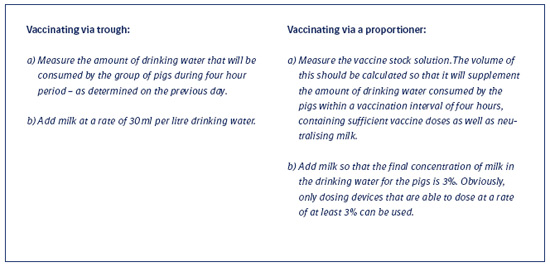
* Rehydration of the vaccine cake
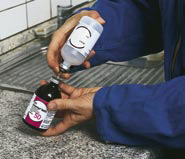
Picture 7.6.3 b
Rehydration of the vaccine cake.
Vaccine cake and diluent are supplied in two different vials. Transfer needles can be ordered separately. The needle should be inserted firstly into the vial containing the diluent, and then – upside down – into the vial containing the vaccine. It is crucial to stick to this sequence because of the vacuum that is used to transfer the diluent.
The vaccine may lose its viability if the cake is dissolved directly in the drinking water. Therefore, it should be rehydrated with the diluent first, and then be added to the milk/water mixture.
* Adding the vaccine to the milk/water mixture
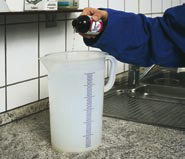
Picture 7.6.3 b
Rehydration of the vaccine cake.
The reconstituted vaccine (2 ml per animal) is poured into the milk/water mixture.
After reconstitution the vaccine should be used immediately. It is not advisable to save remaining vaccine for later, as its efficacy will begin to decline after four hours.
Administration of the vaccine:
* Administration via trough
It is recommended to administer the vaccine via a trough. Following this method the prepared milk/water mixture containing the vaccine is poured into the clean trough. The trough should be freely accessible to the animals due for vaccination.
During the vaccination interval the normal supply of drinking water over a central system should be switched-off and turned back on again after four hours. This procedure is simple, time saving, stress-free and very convenient.
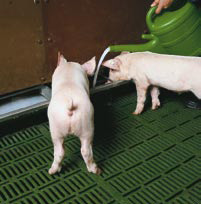
Picture 7.6.3 d
The vaccine can be administered via a clean longitudinal trough.
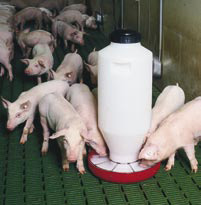
Picture 7.6.3 e
A viable alternative is a round trough, which is temporarily installed in the pen for the time of vaccination.
* Administration via drinking water system
The prepared stock solution, containing the vaccine and milk at a high concentration, should be poured into the reservoir of the proportioner.
Subsequently the water remaining in the pipes should be flushed out until the vaccine-containing, milk-clouded water appears in the drinking nipples that are furthest away from the dosing device. The same procedure should be applied for the nipples in all other pens that are due for vaccination.
If remaining water in the pipes is not flushed out, the intake of vaccine-containing drinking water will be delayed and the success of the vaccination is therefore jeopardised.

Picture 7.6.3 f
The proportioner with the stock solution.

Picture 7.6.3 g
The vaccine-containing water appears in the drinking nipple.
* Control of vaccine intake
At the end of the four-hour period, check whether all the carrier water has been consumed. All of the vaccine-containing water in the trough or the proportioner, respectively, should have been consumed by the pigs.
If the vaccine was administered via a trough, the main drinking water system needs to be turned on again after completion of the vaccination.
The recommended interval of four hours is best adhered to, in order to asure the success of vaccination. Therefore the amount of drinking water intended for the vaccination – as determined on the previous day – should neither be reduced nor increased.
© Boehringer Ingelheim Animal Health GmbH, 2006
All rights reserved. No part of this Technical Manual 3.0 may be reproduced or transmitted in any form or by any means, electronic or photocopy, without permission in writing from Boehringer Ingelheim Animal Health GmbH.




